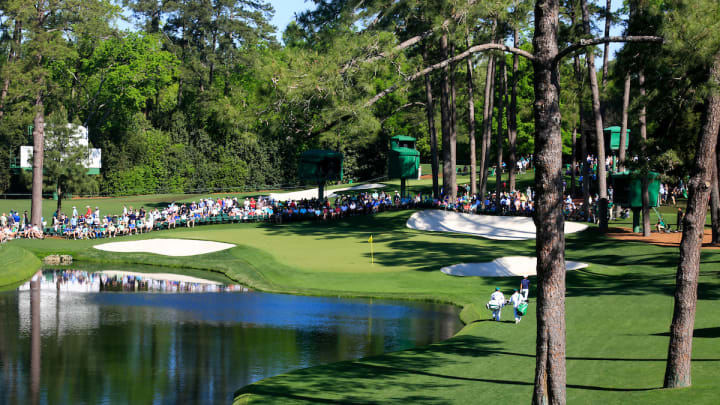Masters 16th Hole: Stats, History, Memorable Moments From Augusta National’s Par-3 ‘Redbud’

A closer look at Augusta National Golf Club's 16th hole for the Masters:
Name: Redbud
Par: 3
2021 yardage: 170
1934 yardage: 145
2021 scoring average: 3.00
All-time scoring average: 3.14
All-time difficulty rank: 11
Lowest year: 2.87 (2020)
Highest year: 3.42 (1950)
THE LAYOUT
The tee shot is over water to an angled green that features two tiers. Bunkers are strategically placed to the green’s fairway opening, right and back left. On Masters Sundays, this is one of the field’s last birdie opportunities.
SIGNIFICANT CHANGES
1946: New green constructed.
1947: Stream transformed into a pond. Green shifted to right. Masters tees moved left.
1961: Masters tees extended and relocated to the left.
1966: Neck of pond and left rear of green filled in.
1973: Left section of pond filled in.
Notes: Course architect Alister Mackenzie originally modeled the 16th hole after a hole from one of his favorite courses, England’s Stoke Poges. Though the hole proved to be perfectly suitable for member play, club co-founder Clifford Roberts wrote in The Story of Augusta National Golf Club that “it was too weak for tournament play … ”. In 1947, Bob Jones reconfigured the hole, which played to about 110 yards. Jones’ design moved the tee to the left of the 15th green and dammed a creek to create a pond that stretched from the tee to alongside the green’s left side. Jones also sloped the green to the left before flattening it closer to the water. The move increased the hole’s length to 170 yards.
The tee shot is over water to an angled green that features two tiers. Bunkers are strategically placed to the green’s fairway opening, right and back left. On Masters Sundays, this is one of the field’s last birdie opportunities.
ODDS AND ENDS
In 1960, an agitated Arnold Palmer tossed his wedge at caddie Nathaniel “Iron Man” Avery after a poor wedge shot at the par-5 15th hole led to a par. “Mr. Palmer, are we chokin’?” Avery asked. Palmer settled down with a par at 16, then birdied 17 and 18 to win by a shot over Ken Venturi. … The Masters’ first three-way playoff may have had to wait had Arnold Palmer not chipped in for birdie at the 16th hole during the 1962 final round. Palmer then birdied the 17th and was part of a three-playoff that Palmer won the next day over Gary Player and Dow Finsterwald. … The anxiety that the 16th can cause some players is apparently real. In 1967, eventual champion Gay Brewer reportedly was handed a cup of water as he arrived at the teeing ground. His hands shook so badly that he had trouble getting the cup to his mouth. … In 1968, Bert Yancey birdied the 16th in each of his four Masters rounds. … In 1986, 46-year-old Jack Nicklaus continued his back-nine charge up the leaderboard by putting more pressure on leader Seve Ballesteros at the 16th hole. Nicklaus, trailing Ballesteros by two strokes, took dead aim with a 5-iron. “Be the right club,” said Nicklaus’ caddie, son Jackie. To which Nicklaus replied, “It is,” while leaning over to pick up his tee. The ball hit about 8 feet right of the hole and then rolled to within 3 feet. Nicklaus converted the birdie to create an undeniable partisan roar that could be heard by the Spaniard back on the 15th fairway. Ballesteros made bogey at the 15th to fall back into a tie with Nicklaus, who birdied the 17th to take the lead for good and wound up winning his sixth green jacket. … In 1999, Davis Love III pulled his tee shot, not far enough left to find the pond, but long enough to clear the bunker. But what Love left himself was a near impossible opportunity to chip in. He was above the hole, and the green was running away from him. His only option was to hit back up to the ridge and then hope, pray, that it landed softly enough to deaden the speed and then U-turn back toward the hole. The ball did exactly that, but hit a spike mark seemingly to steer right of its intended line in the final few feet. The ball somehow veered back left and caught the cup’s right edge before falling. The birdie, though, was not enough to catch Jose Maria Olazabal, who won by two strokes over Love. …
Six years later, Tiger Woods, who had won the Masters in 1997, 2001 and 2002, faced a similar situation as Love did in 1999. Woods held a one-shot lead over playing competitor Chris DiMarco as they played the 16th hole. DiMarco’s tee shot came to rest 15 feet from the hole, and Woods’ ended up against the thick second cut on the green’s backside. In surveying his approach shot, Woods settled upon an old ball mark, roughly 20 feet left of and above the hole, as his target on the green. Woods executed the first part of the shot to perfection by hitting his target. “Here it comes,” CBS commentator Verne Lundquist said. Then the ball started tracking on the right line toward the cup. “Oh, my goodness,” Lundquist said. With every rotation, the gallery’s thunderous roar grew. Then the ball’s roll slowed and paused on the cup’s edge as the TV camera zoomed in on the ball’s Nike swoosh logo. Then the ball dropped into the cup for the birdie. “Oh, wow. In your life have you ever seen anything like that,” Lundquist boomed. DiMarco failed to match Woods’ birdie and fell behind two strokes with two holes remaining. As DiMarco closed with pars at 17 and 18, Woods frittered the lead away his lead with bogeys to force a playoff. In the first Masters playoff to start at the 18th, Woods won his fourth green jacket with a birdie. … There have been 22 aces at No. 16, and Herman Barron’s 11 in 1950 stands as the hole’s highest score. Barron found the pond three times.
MEMORABLE MOMENT
1975: Though Jack Nicklaus began the final round alone in second place, a stroke behind former Ohio State University teammate Tom Weiskopf, he went off with Tom Watson in the next-to-last pairing. As is often the case on Sundays at the Masters, the leaderboard began to fluctuate on the back nine. Through the 13th hole, Nicklaus held a one-shot lead over Weiskopf. At the 14th, Nicklaus made bogey and, minutes later, Weiskopf made birdie there to regain the lead. At the par-3 16th, Nicklaus left his tee shot 40 feet short of the cup, and Watson hit two tee shots into the greenside pond. The delay created by Watson allowed Nicklaus more time to survey his putt. Meanwhile, Miller and Weiskopf were both sinking respective birdie putts at the 15th. “What a tremendous putt by Tom Weiskopf, and that is going to be evil music ringing in Nicklaus’ ears,” said CBS analyst Ben Wright as Nicklaus, still a stroke behind Weiskopf, waited for the gallery to quiet. Nicklaus then created his own noise by rolling in his uphill putt, thrusting his putter skyward and high-stepping a few steps back in the direction of the 16th tee where Miller and Weiskopf were waiting. A rattled Weiskopf, who later called Nicklaus’ putt the greatest he had ever seen, made bogey on the 16th to vault Nicklaus into a lead that he did not relinquish. The win was Nicklaus’ fifth Masters title. The runner-up finish was Weiskopf’s third in four years and fourth in seven years at Augusta National.
SEE MORE OF AUGUSTA NATIONAL'S BACK NINE
10 | 11 | 12 | 13 | 14 | 15 | 16 | 17 | 18
